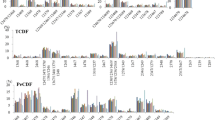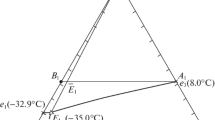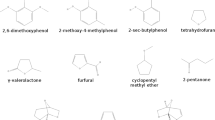Abstract
A Monte Carlo model was developed to characterize the molecular composition of polychlorinated alkane mixtures. The model is based upon a simulation of the free-radical chlorination process by which polychlorinated alkane mixtures are produced industrially from n-alkanes. In the model, the free-radical chlorination reaction was simulated by randomly selecting a position on a partially converted alkane molecule for target by chlorine free-radical attack. The relative reactivities of the hydrogen atoms on the alkane chain towards chlorine free-radical substitution were either determined experimentally or extrapolated from experimental results and incorporated into the model. The result of the simulation is the prediction of the detailed molecular composition of any PCA mixture. Good agreement was found when comparing the distribution of molecules predicted by the model to analytically determined distributions of real PCA mixtures. Results from the model were then coupled with rules describing the action of biological enzymes to estimate the upper limit possible for the aerobic biodegradation of PCA mixtures.








Similar content being viewed by others
Abbreviations
- 1,10-DCD:
-
1,10-dichlorodecane
- 1,2-DCD:
-
1,2-dichlorodecane
- 1-CD:
-
1-chlorodecane
- 3-CD:
-
3-chlorodecane
- 5,6-DCD:
-
5,6-dichlorodecane
- A 1-CD :
-
The GC chromatogram peak areas associated with 1-CD
- A 3-CD :
-
The GC chromatogram peak areas associated with 3-CD
- EPA:
-
United States Environmental Protection Agency
- GC:
-
Gas Chromatograph
- N :
-
Number of carbon atoms in an unbranched carbon chain
- NMR:
-
Nuclear Magnetic Resonance spectroscopy
- PCA:
-
Polychlorinated Alkane
- R P/S :
-
The relative reactivity of a hydrogen atom located on a primary carbon to a hydrogen atom located on a secondary carbon atom
- UV:
-
Ultraviolet
- h ν:
-
Light source (photon)
- β:
-
Number of chlorine atoms bound to a PCA molecule
- (π P /π S ):
-
The probability of encountering a hydrogen atom on a secondary carbon relative to the probability of encountering a hydrogen atom on a primary carbon
References
Allpress JDG, Gowland PC (1999) Biodegradation of chlorinated paraffins and long chain chloroalkanes by Rhodococcus sp. S45-1. Int Biodeter Biodegrad 43:173–179
Armfield SJ, Salis PJ, Baker PB, Bull AT, Hardman DJ (1995) Dehalogenation of haloalkanes by Rhodococcus erythropolis Y2. Biodegradation 6:237–246
Baker KH, Herson DS (1994) Bioremediation, 1st edn. McGraw-Hill Inc., New York
Colburne N, Stern ES (1965) The chlorination of some n-alkanes and alkyl chlorides. J Chem Soc 3599–3605
Curragh H, Flynn O, Larkin MJ, Stafford TM, Hamilton JTG, Harper DB (1994) Haloalkane degradation and assimilation by Rhodococcus rhodochrous NCIMB 13064. Microbiology 140:1433–1442
Damborsky J, Rorije E, Jensenska A, Nagata Y, Klopman G, Peijnenburg WJGM (2001) Structure-specific relationships for haloalkane dehalogenases. Environ Toxicol Chem 20:2681–2689
Environment-Canada (1993) Priority substances list assessment report: chlorinated paraffins. pp 1–26
Environment-Canada (1997) Toxic substances management policy: short chain chlorinated paraffins. pp 1–17
Heath E, Bratty M, Brown W (2002) Biodegradation of chlorinated alkanes by Pseudomonas sp.273. Zbornik referatov s posvetovanja - Slovenski kemijski dnevi 2002 (Conference Proceeding) 1:42–51
Heath E, Brown WA, Jensen SR, Bratty M (2006) Biodegradation of chlorinated alkanes and their commercial mixtures by Pseudomonas sp. strain 273. J Ind Microbiol Biotechnol 33:197–207
Huyser ES (1969) Methods in free-radical chemistry, vol 1. Marcel Dekker, New York
Madeley JRB, Robin DN (1980) Chlorinated paraffins and the environment. Am Chem Soc 14:1215–1221
Mathews CK, Van Holde KE (1996) Biochemistry, 2nd edn. The Benjamin/Cummings Publishing Company, Inc
Marín M, Smits TH, van Beilen J, Rojo F (2001) The alkane hydroxylase gene of Burkholderia cepacia RR10 is under catabolite repression control. J Bacteriol 183:4202–4209
McMurry J (1994) Fundamentals of organic chemistry, 3rd edn. Brooks/Cole Publishing Company, Belmont, California
Muller MD, Schmid PP (1984) GC/MS analysis of chlorinated paraffins with negative ion chemical ionization. J High Resolut Chromatogr 7:33–37
Shojania S (1999) The enumeration of isomeric structures for polychlorinated n-alkanes. Chemosphere 38:2125–2141
Tomy GT, Fisk AT, Westmore JB, Muir DCG (1998) Environmental chemistry and toxicology of polychlorinated n-alkanes. Rev Environ Contam Toxicol 158:53–128
Tomy GT, Billeck B, Stern GA (2000a) Synthesis, isolation and purification of C10-C13 polychloro-n-alkanes for use as standards in environmental analysis. Chemosphere 40:679–683
Tomy GT, Muir DCG, Stern GA, Westmore JB (2000b) Levels of C10-C13 polychloro-n-alkanes in marine mammals from the Arctic and the St. Lawrence River Estuary. Environ Sci Technol 34:1615–1619
van Beilen JB, Wubbolts MG, Witholt B (1994) Genetics of alkane oxidation by Pseudomonas oleovorans. Biodegradation 5:161–174
Vogel TM, Criddle CS, McCarty PL (1987) Transformation of halogenated aliphatic compounds. Environ Sci Technol 21:722–736
Wischnak C, Müller R (2000) Degradation of chlorinated compounds. In: Klein J (ed) Environmental processes II – soil decontamination, 2nd edn., vol 11b. Wiley-Vch, Weinheim, pp 241–271
Wischnak C, Loffler FE, Li J, Urbance JW, Muller R (1998) Pseudomonas sp strain 273, an aerobic alpha-omega-dichloroalkane-degrading bacterium. Appl Environ Microbiol 64:3507–3511
Wyatt I, Coutts CT, Elcombe CR (1993) The effect of chlorinated paraffins on hepatic enzymes and thyroid hormones. Toxicology 77:81–90
Acknowledgements
This work was supported by the National Science and Engineering Research Council of Canada (NSERC), and the North Atlantic Treaty Organization (NATO).
Author information
Authors and Affiliations
Corresponding author
Appendix: derivation of analytical solution
Appendix: derivation of analytical solution
For the chlorination process governed by equation (Tomy et al. 1998), each isomer i containing β chlorine atoms can be identified by the set of β elements \({{\bf S}_{i}^\beta}\), as:
If the hydrogen atoms are numbered in sequence from the end of the molecule, 1 ≤ p j ≤ 2n + 2 represents the position of the hydrogen atom in the alkane chain that has been replaced by a chlorine atom. It follows that each element of the set is unique, repeats are not permitted, and the total number of elements in the set cannot exceed 2n + 2. The molar concentration of an isomer containing n carbon and β chlorine atoms distributed according to the set \({{\bf S}_{i}^\beta}\) is given by \({C_{n,\beta}^{{\bf S}_i^\beta}}\). The total concentration of all unique isomers containing β chlorine atoms, C n,β, is given by:
The molar ratio of chloride atoms to alkane molecules in the hydrocarbon phase is given by:
Choosing a basis of one mole of alkane chains, \({\sum_{\beta =0}^{2n+2} {C_{n,\beta}}=1}\) and the total amount of chlorine contained in the hydrocarbon phase is equal to:
In a closed batch process, the change in the chlorine content in the hydrocarbon phase as the extent of the reaction proceeds is given by:
The rate of formation of an isomer \({{\bf S}_{i}^\beta}\) by the replacement of a hydrogen atom at any position p j in a reactant \({\bf S}_i^{\beta -1} =\left\{ {p_1,p_2,p_3,\ldots p_{\beta -1} } \right\}\), where \({\bf S}_i^{\beta -1} \subset {\bf S}_i^\beta \) and \(p_j \notin \left\{ {p_1,p_2,p_3,\ldots,p_{\beta -1} } \right\}\) is defined in the usual way in terms of the reacting species \({{\bf S}_i^{\beta -1}}\) , represented as \(r_{n,\beta }^{{\bf S}_i^{\beta -1} \rightarrow{\bf S}_i^\beta}\). The total number of independent reactants that can form the isomer \({{\bf S}_i^\beta }\) is given by the binomial coefficient formula \(\left( {{\begin{array}{c} \beta \\ {\beta -\hbox{1}} \\ \end{array}}} \right)\), which yields β as a result. The set of β reactants includes all independent subsets of the set \({{\bf S}_i^\beta}\) having β −1 elements. In the general case where β < 2n + 2, the isomer \({{\bf S}_i^\beta }\) can be lost from the system if one of the hydrogen atoms is displaced by a chlorine atom to yield an isomer with β + 1 chlorine atoms. For each isomer \({{\bf S}_i^\beta }\), there are 2n + 2−β possible products. The net rate of formation of the isomer \({{\bf S}_i^\beta }\) can be determined by considering the sum of all β reactions involving the complete set of isomers containing β −1 chlorine atoms, less the 2n + 2−β possible rates of destruction. Finally, the net rate of removal considering all isomers containing β chlorine atoms can be derived by summing the expressions associated with all isomers containing this degree of chlorination, and is equal to dC n,β/dt in Eq. (8). The complete expression is cumbersome, but is omitted here for clarity.
If chlorine is in excess, the reaction is first order, described by a rate equation of the form:
For reactants consisting of pure n-alkane, the initial conditions are given by:
It is more convenient to work in the chlorination domain. Applying the chain rule to (8) provides the necessary conversion from the time domain.
In the simplest case it can be assumed that all hydrogen atoms are replaced at equal rates once encountered by a chlorine free-radical. This is equivalent to assuming that the rate constant of any isomer is proportional to the number of hydrogen atoms on the reacting alkane. From this result, all molecules with the same number of chlorine atoms will have the same reactivity. Thus, from Eq. (9):
At any instant during the chlorination process:
Under the simplifying assumption, it follows from a mass balance that:
Combining:
The values of rate constants are proportional to the number of hydrogen in the carbon chain. Selecting 1 as a basis for the rate constant k n,(2n+1) it follows:
By inspection, the above expression is equal to the total moles of hydrogen, which can also be written as:
These equations can be integrated subject to the condition C n,β = 0 when X = 0 to yield the solution:
An alternative solution to this problem, previously published was used by Colburne and Stern (1965) for comparing experimental chlorination data. This model is of the form:
The assumption that allows for this solution is that all alkane molecules react with chlorine radicals at equal rates regardless of the degree of chlorination. However, the model violates the mass balance, or the condition that \(\mathop {\lim }\limits_{\beta \rightarrow 2n+2} {C_{n,2n+2}}/{C_n}=1\) and hence does not represent a correct solution.
Rights and permissions
About this article
Cite this article
Jensen, S.R., Brown, W.A., Heath, E. et al. Characterization of polychlorinated alkane mixtures—a Monte Carlo modeling approach. Biodegradation 18, 703–717 (2007). https://doi.org/10.1007/s10532-007-9099-5
Received:
Accepted:
Published:
Issue Date:
DOI: https://doi.org/10.1007/s10532-007-9099-5




